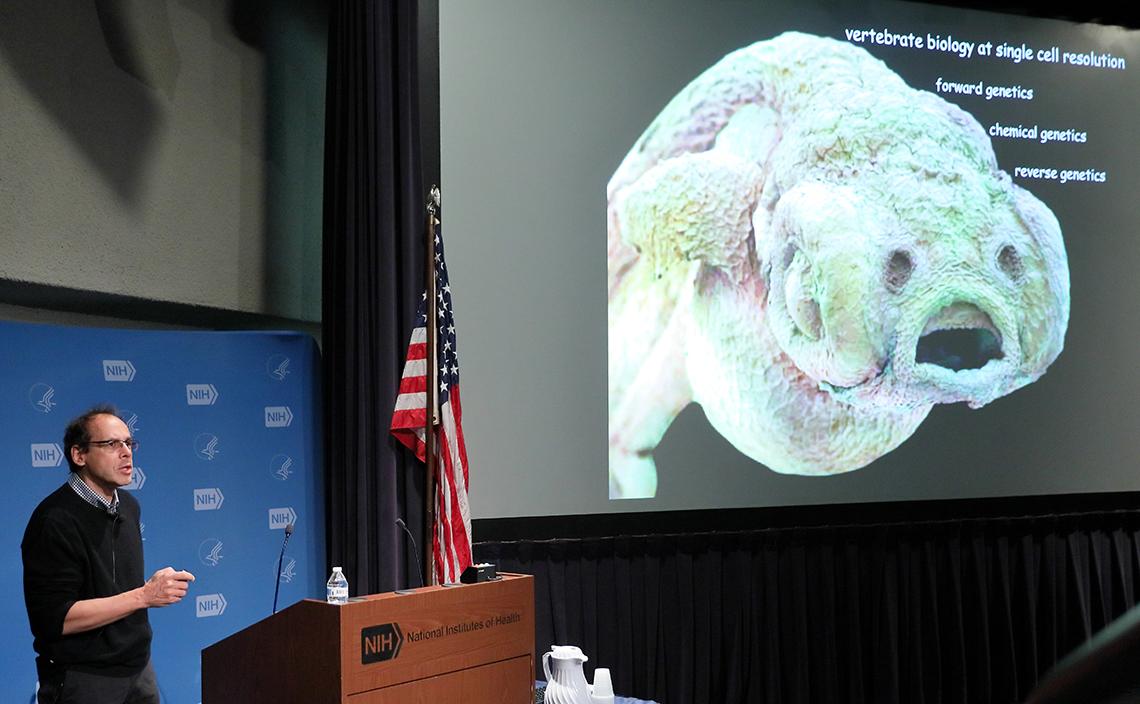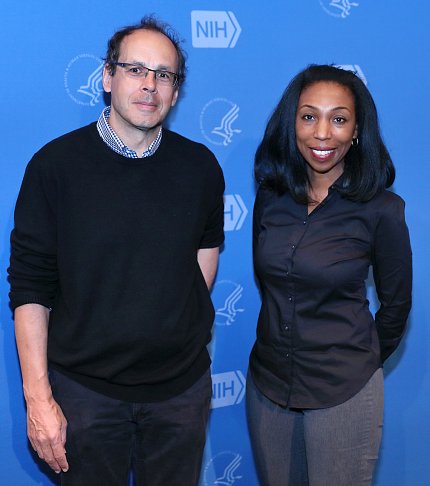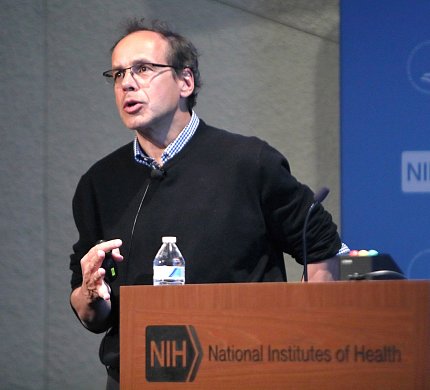The Faults in Our Genes
What Organ Formation, Function Tell Us About Overcoming Mutations

Photo: Chia-Chi Charlie Chang
Why do some mutations lead to disease while others seemingly overcome injury without harm? How do some cells pinch hit for their missing or hurt comrades?
With new imaging and editing tools, scientists can see intra-cell behavior firsthand like never before and can potentially mimic the beneficial cell actions (and limit the misdeeds) to improve the lives of people with genetic conditions.
That’s according to Dr. Didier Stainier, director of the department of developmental genetics of the Max Planck Institute for Heart and Lung Research at W.G. Kerckhoff Institute in Germany. He gave a talk, “Genetic Compensation and Transcriptional Adaptation,” for NCI’s Center for Cancer Research Grand Rounds recently in Lipsett Amphitheater.
A longtime NIH grantee, Stainier is a “world renowned expert in elucidating mechanisms that govern organ development”—specifically heart, pancreas and liver, said Dr. Kandice Tanner, Stadtman investigator and chief of the tissue morphodynamics unit in NCI’s Laboratory of Cell Biology, who introduced the speaker.
For nearly two decades, Stainier served as principal investigator on awards from NIDDK and NHLBI at the University of California, San Francisco, from 1995 to 2012.
Relocated to Germany since 2012, he and his research group use forward and reverse genetics to study the role of mutations in health and disease as various organisms—zebrafish and mice—form heart, blood vessels, pancreas, lungs and liver.
Tracing his research back to its early days, Stainier explained why he and others examine the popular aquarium fish, which belongs to the minnow family, as a vertebrate research model with potential applications to human organ development and function.
Zebrafish, he noted, are ideal for studying organ formation for several reasons, including their high fertility rate, rapid development of organs (the hearts start beating 24 hours after fertilization) and their transparence.
“One can easily see and follow the blood cells moving into and out of [the heart],” Stainier said, showing several videos with ever-increasing definition of zebrafish hearts pumping over the past few decades, from 1990 to now. “So you can imagine how easy it was to identify mutations that affect either the form or function of this organ…It took many years and also transgenic techniques to be able to label the cardiomyocytes—the muscle cells of the heart. The imaging has been key to the various advances, not only in terms of formulating the hypotheses but also in looking at the various mutants that came out of the forward genetics screens.”

Photo: Chia-Chi Charlie Chang
It was by observing the development of hearts in zebrafish, mouse and other organisms that researchers were able to identify the heart wall’s endocardium cells, watch the evolution of the cardiac pump mechanism and describe how the organ forms finger-like projections, called cardiac trabeculae, within its ventricles.
In addition to being able to map various organ structures and functions, Stainier and colleagues observed and documented other phenomena such as genetic compensation and transcriptional adaptation.

Photo: Chia-Chi Charlie Chang
Genetic compensation, he explained, involves changes in RNA or protein levels that can functionally compensate for the loss of function of another gene. Transcriptional adaptation refers to changes in RNA levels that result from a mutation, but not from the loss of gene function.
“Transcriptional adaptation can in some cases lead to genetic compensation,” Stainier added.
As a “classic illustration model” of the phenomenon, he described the genetic disorder Duchenne muscular dystrophy (DMD). DMD occurs when mutant genes obstruct proteins that build and maintain healthy muscles. In mice with DMD, the muscle-builder protein dystrophin is missing and another related muscle-builder, utrophin, goes into overdrive production—seemingly to make up for the lack of dystrophin.
Turns out this kind of cell behavior—up-regulation—is not uncommon.
“This phenomenon of compensation by modifier genes is not restricted to the dystrophin-utrophin model, but has been observed in many other cases of mutations for many other genes—not an isolated phenomenon by any means,” Stainier said.

Photo: Chia-Chi Charlie Chang
But, he explained, scientists want to fully understand how the process starts and what occurs to prompt the actions.
“The main question we had at this point is, what is the trigger for the transcriptional adaptation response?” Stainier said.
His research group tested several hypothetical prompts, finally settling on damaged or mutant RNA as the culprit. That led to more questions.
“Why do some genetic mutations cause disease while others do not?” Stainier asked. Are some mutations more or less severe than others? Also, how can more effective therapies be developed that would “enhance an organism’s robustness to a mutation rather than trying to correct the mutation?”
Investigators now are exploring ways to trigger up-regulation of the specific compensating proteins and trying to understand how the degraded mutant RNA prompts the response in the first place.
“Many black boxes remain,” Stainier concluded.
HHS’ers can access the full lecture (and previous NCI CCR Grand Rounds talks) online at https://videocast.nih.gov/summary.asp?Live=26180&bhcp=1.
